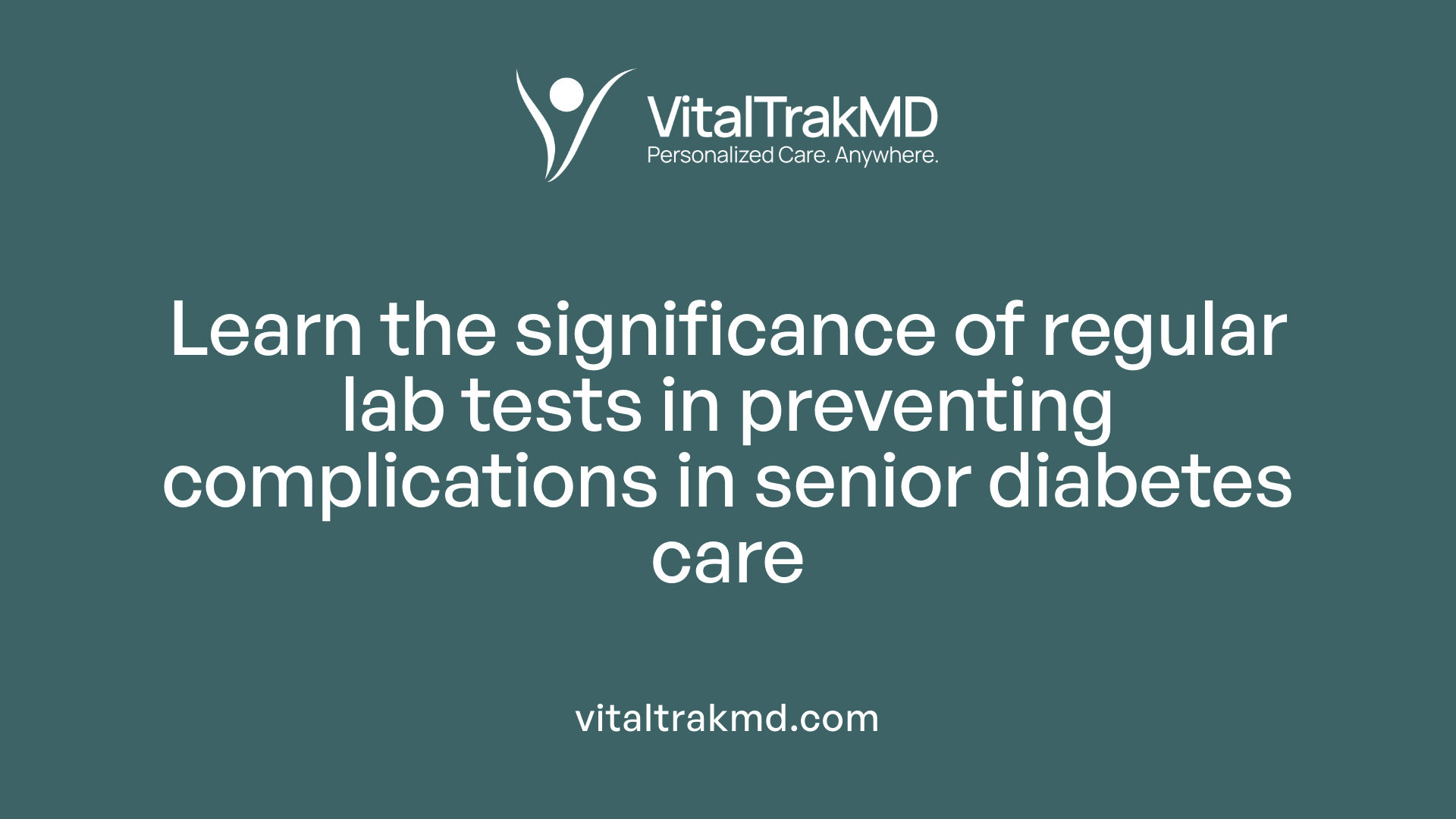Why Routine Lab Tests Are Vital for Managing Diabetes in Seniors

Understanding the Significance of Regular Laboratory Monitoring
Managing diabetes effectively in seniors requires a comprehensive approach that includes routine laboratory testing. These tests are pivotal in diagnosing, monitoring, and preventing complications associated with diabetes, ensuring that older adults maintain a good quality of life. This article explores why regular lab assessments are integral to the health and well-being of seniors with diabetes, emphasizing early detection, personalized treatment, and proactive disease management.
Monitoring Glycemic Control through A1C Testing
What is the primary test used to assess long-term glycemic control in diabetes management?
The main test used to evaluate long-term blood sugar levels in individuals with diabetes is the A1C test. This blood test measures the percentage of hemoglobin in the blood that is coated with sugar, which indicates average blood glucose levels over the past two to three months. It provides a snapshot of how well blood sugar has been managed over time, helping healthcare providers determine if treatment adjustments are necessary.
How does regular blood sugar monitoring assist in managing diabetes effectively?
Regular blood glucose testing plays a vital role in diabetes management. It offers immediate data on blood sugar levels, allowing individuals to understand how various factors, such as meals, physical activity, medication schedules, stress, and illness, influence their blood sugar. This real-time information helps patients and their healthcare teams make informed decisions about medication doses, dietary choices, and lifestyle modifications.
Frequent monitoring can identify patterns of high or low blood sugar, enabling timely interventions to prevent complications like hypoglycemia or hyperglycemia. For example, detecting low blood sugar early can prevent severe episodes that might cause dizziness, confusion, or loss of consciousness. Conversely, recognizing spikes after meals can inform dietary adjustments.
Moreover, blood sugar measurements taken regularly complement A1C results by providing ongoing, updated information about daily fluctuations. While A1C reflects overall control, daily blood tests help fine-tune treatment plans, improve safety, and reduce the risk of long-term complications such as nerve damage, eye disease, and cardiovascular problems.
In summary, regular blood glucose monitoring empowers individuals with diabetes to actively participate in managing their condition, improve treatment adherence, and achieve better health outcomes through timely adjustments and sustained control.
The Role of Blood Glucose Testing and Continuous Monitoring

What are the primary methods of blood sugar monitoring at home?
Managing diabetes effectively relies heavily on regular blood sugar monitoring. The main methods used at home include fingerstick blood glucose tests and continuous glucose monitoring (CGM) systems. Fingerstick testing requires pricking the fingertip with a lancet to draw a small blood sample, which is then applied to a test strip inserted into a glucose meter. Results are available within seconds, allowing patients to make immediate decisions about their diet, medication, or activity.
CGMs involve inserting a tiny sensor under the skin, typically on the abdomen or arm. This sensor measures glucose levels in the interstitial fluid every few minutes, providing a continuous stream of data. Many CGMs connect wirelessly to smartphones or dedicated devices, offering real-time readings and alerts for high or low blood sugar levels. They are especially valuable for detecting fluctuations and hypoglycemia episodes that might be missed with traditional testing.
Both methods are vital in enabling patients to manage their condition proactively. Fingerstick tests are usually used multiple times daily, especially around meals or during suspected hypoglycemia, while CGMs provide a comprehensive picture of glucose trends over time.
How does regular laboratory testing impact health outcomes in senior diabetes management?
Regular laboratory tests are fundamental for monitoring long-term diabetes control and preventing complications, especially in older adults. Tests such as the hemoglobin A1C, fasting blood glucose, and lipid panels help clinicians assess blood sugar control and cardiovascular risk. While routine checkups are commonly performed, evidence indicates that they alone may not directly improve mental or physical health outcomes in seniors.
However, combining lab testing with structured self-management programs and digital health interventions, including mobile health (mHealth) tools, has been shown to produce modest but significant improvements. These strategies can enhance patients' understanding of their condition, promote behavior change, and motivate adherence to treatment plans.
For example, improvements in blood pressure, lipid profiles, and glycemic control are associated with reduced risk of vascular and renal complications. Moreover, integrating regular testing with personalized education helps seniors better navigate their disease management, increasing self-efficacy.
In summary, while laboratory tests are critical for detection and monitoring, the greatest health benefits arise when these are incorporated into comprehensive management approaches. Digital tools and tailored education enhance the effectiveness of testing, leading to better health outcomes in older adults with diabetes.
Importance of Routine Lab Tests for Early Detection and Prevention
Routine laboratory testing and glucose monitoring are essential components of effective diabetes management, especially in older adults. These tests serve multiple purposes, from diagnosing undetected cases of diabetes to preventing severe complications.
Screening for undiagnosed diabetes often involves measuring HbA1c levels, fasting blood glucose, or performing an oral glucose tolerance test. Early detection enables timely intervention through lifestyle modifications and medication adjustments, significantly reducing the risk of developing long-term microvascular issues like nerve damage, kidney disease, and vision loss.
Regular testing also plays a crucial role in monitoring disease control. In senior diabetics, adhering to scheduled assessments such as hemoglobin A1c, urine albumin-to-creatinine ratio (ACR), and kidney function tests helps identify early signs of complications. For example, elevated ACR levels suggest kidney damage, prompting early treatments to slow disease progression.
The benefits of consistent testing extend beyond early detection. They allow healthcare providers to tailor treatment plans more effectively, reducing the likelihood of emergencies like hypoglycemia or diabetic ketoacidosis. In particular, tools like continuous glucose monitors (CGMs) enhance safety by providing real-time data, alerting users to rapid blood sugar changes.
Implementing routine lab tests in seniors transforms reactive care into proactive management. It supports ongoing control of blood glucose levels, minimizes the risk of devastating complications such as cardiovascular diseases, limb amputations, or blindness, and ultimately enhances quality of life.
| Test Type | Purpose | How It Helps | Recommended Frequency |
|---|---|---|---|
| HbA1c | Long-term glycemic control | Guides treatment adjustments, monitors control over 2-3 months | At least twice a year, or quarterly if unstable |
| Fasting Blood Glucose | Detects current blood sugar levels | Identifies undiagnosed diabetes, assesses daily control | Annually or as needed |
| Urinalysis & Albumin-to-Creatinine Ratio | Kidney health | Detects early kidney damage, prompts intervention | Annually |
| Lipid Panel | Cardiovascular risk | Assesses cholesterol for heart disease risk | Annually |
| Kidney Function Tests | Kidney health | Monitors for nephropathy | Every 1-2 years |
In conclusion, routine lab tests are invaluable in the early detection and management of diabetes in senior patients, enabling healthcare teams to prevent severe complications and maintain health and independence.
Preventive Care and Management Strategies in Senior Diabetes
Routine laboratory tests play a crucial role in managing diabetes among older adults. These tests help healthcare providers diagnose the condition accurately, monitor how well blood sugar levels are controlled over time, and detect early signs of complications such as kidney disease, eye issues, and cardiovascular problems. For instance, the hemoglobin A1C test reflects average blood glucose levels over the past 2–3 months, guiding treatment adjustments. Urinalysis, especially testing for albumin, helps identify kidney damage early, allowing for timely interventions. Lipid panels assess cholesterol and triglycerides, reducing the risk of heart disease, a common concern in seniors with diabetes.
The significance of regular testing extends beyond glucose control. It enables personalized care plans tailored to an individual's health status, functional capacity, and risk factors. Individuals with comorbidities like anemia or hemoglobinopathies may have altered A1C readings, making other tests and close monitoring even more important.
Guidelines recommend frequent testing for those with poorly controlled diabetes and in cases where medication adjustments are made. These regular assessments support early detection of issues, minimize the risk of severe complications like blindness and kidney failure, and improve overall health outcomes. In addition, screening for geriatric syndromes such as depression or cognitive decline ensures holistic management, addressing factors that may impair self-care.
The benefits of routine lab testing include timely interventions that help maintain independence, reduce hospitalizations, and enhance quality of life. Fostered by continuous evaluation, this proactive approach encourages optimal health in seniors living with diabetes.
Impact on Quality of Life and Health Outcomes
 Proactive disease management through regular health checks is vital for older adults with diabetes. Routine laboratory testing, such as A1C, blood glucose, kidney function tests, and lipid panels, helps detect complications early and guides personalized treatment adjustments. Although regular checkups are standard, studies suggest they alone do not directly improve mental or physical health outcomes. Instead, combining lab tests with structured self-management programs, educational support, and mobile health (mHealth) interventions enhances disease control.
Proactive disease management through regular health checks is vital for older adults with diabetes. Routine laboratory testing, such as A1C, blood glucose, kidney function tests, and lipid panels, helps detect complications early and guides personalized treatment adjustments. Although regular checkups are standard, studies suggest they alone do not directly improve mental or physical health outcomes. Instead, combining lab tests with structured self-management programs, educational support, and mobile health (mHealth) interventions enhances disease control.
These combined strategies can lead to meaningful improvements in blood sugar levels, cholesterol, and blood pressure. They also promote better self-efficacy, behavior change, and disease understanding among seniors, which are crucial for managing complex health conditions.
Routine testing contributes significantly to early detection of diabetes-related complications like nephropathy and cardiovascular problems. Detecting issues early allows tailored interventions that prevent progression to severe outcomes such as blindness, kidney failure, or heart attacks. Personalized screening ensures that each senior receives appropriate testing frequency based on their health status, thus optimizing prevention efforts.
In summary, the integration of regular lab assessments with comprehensive management strategies enhances the overall quality of life for senior diabetics. It fosters proactive care, reduces long-term complications, and supports healthier aging by enabling timely treatment modifications and ongoing health monitoring.
Special Care, Palliative Approaches, and Technology Utilization
 Recognizing when an elderly person with diabetes needs assisted living involves careful observation of their ability to control blood sugar levels, frequency of hospital visits, and signs of physical or cognitive decline. These indicators suggest that additional support might be necessary to ensure safety and effective health management. Structured assessments, along with continuous blood glucose monitoring, can help determine the optimal timing for transitioning to assisted living, helping to prevent medical emergencies and maintaining quality of life.
Recognizing when an elderly person with diabetes needs assisted living involves careful observation of their ability to control blood sugar levels, frequency of hospital visits, and signs of physical or cognitive decline. These indicators suggest that additional support might be necessary to ensure safety and effective health management. Structured assessments, along with continuous blood glucose monitoring, can help determine the optimal timing for transitioning to assisted living, helping to prevent medical emergencies and maintaining quality of life.
Routine lab testing is fundamental in managing diabetes among seniors. Tests such as the A1C, blood glucose, kidney function panels, and lipid profiles offer vital insights into glycemic control and potential complications. These assessments guide personalized treatment plans based on the individual's overall health, risk factors, and functional capabilities. Additionally, screening for conditions like cognitive impairment, depression, and risk of falls helps identify issues that could interfere with self-management. Setting appropriate, individualized glycemic targets—less strict for frail or multi-morbid patients—reduces hypoglycemia risks while maintaining effective control. Overall, regular lab tests and screenings improve health outcomes by enabling early intervention, tailored therapies, and better management of coexisting health issues.
Routine laboratory evaluation plays a significant role in enhancing health outcomes for senior diabetes patients. Early detection of complications through regular testing promptly allows clinicians to adjust treatment, preventing severe issues such as kidney failure, cardiovascular disease, or nerve damage. While routine checkups alone often do not directly translate into better physical or mental health, combining lab testing with structured self-management programs and digital health tools has shown promising results. These strategies assist older adults in achieving modest yet impactful improvements in blood glucose regulation, lipid levels, and blood pressure. Moreover, they enhance self-efficacy, encouraging healthier behaviors and increasing disease understanding. Ultimately, integrating regular lab assessments with comprehensive educational and behavioral support maximizes the positive influence on health, supporting healthier aging for seniors with diabetes.
Ensuring Optimal Care Through Consistent Testing
Routine laboratory testing is a cornerstone of effective diabetes management in seniors. It enables early detection of complications, guides personalized treatment, and supports ongoing disease control, all of which are crucial for maintaining independence and enhancing quality of life. By integrating regular tests with comprehensive care strategies, healthcare providers can better address the unique needs of elderly diabetics, preventing serious health issues and fostering healthier aging.
References
- Health Checks for People with Diabetes
- Diabetes Management in the Elderly - PMC
- Diagnostic Testing Critical to 133 Million Americans Living with ...
- Diabetes Care and the Importance of Regular Check-ups Wray ...
- Guidelines and Recommendations for Laboratory Analysis in the ...
- Blood sugar testing: Why, when and how - Mayo Clinic
- Diabetes Mellitus: Screening and Diagnosis - AAFP
- The Role of Blood Glucose Monitoring in Diabetes Management
- Why Monitoring Blood Glucose Levels Are Important | Onetouch®
- Demystifying Diabetes in Seniors: Understanding the Types for ...
Recent articles
Want to Feel Better and Live Healthier?
Join hundreds of patients taking control of their health with personalized care that fits their life – not the other way around.
Rated 4.8/5 by 32+ customers







